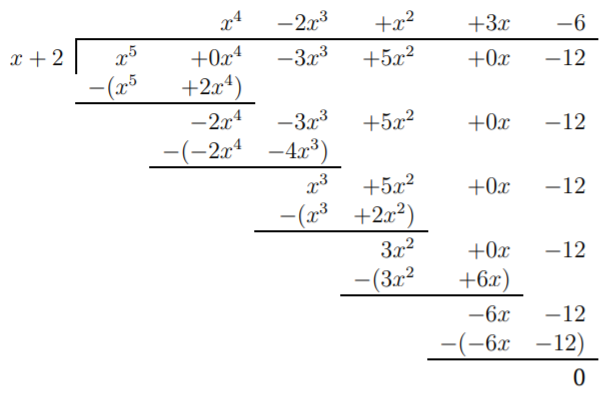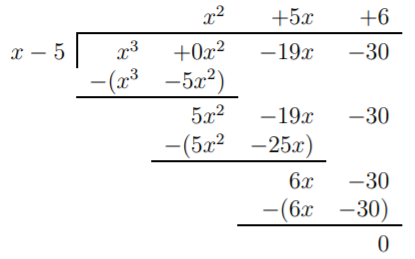8.2: Dividing by (x - c)
- Page ID
- 48997
\( \newcommand{\vecs}[1]{\overset { \scriptstyle \rightharpoonup} {\mathbf{#1}} } \)
\( \newcommand{\vecd}[1]{\overset{-\!-\!\rightharpoonup}{\vphantom{a}\smash {#1}}} \)
\( \newcommand{\id}{\mathrm{id}}\) \( \newcommand{\Span}{\mathrm{span}}\)
( \newcommand{\kernel}{\mathrm{null}\,}\) \( \newcommand{\range}{\mathrm{range}\,}\)
\( \newcommand{\RealPart}{\mathrm{Re}}\) \( \newcommand{\ImaginaryPart}{\mathrm{Im}}\)
\( \newcommand{\Argument}{\mathrm{Arg}}\) \( \newcommand{\norm}[1]{\| #1 \|}\)
\( \newcommand{\inner}[2]{\langle #1, #2 \rangle}\)
\( \newcommand{\Span}{\mathrm{span}}\)
\( \newcommand{\id}{\mathrm{id}}\)
\( \newcommand{\Span}{\mathrm{span}}\)
\( \newcommand{\kernel}{\mathrm{null}\,}\)
\( \newcommand{\range}{\mathrm{range}\,}\)
\( \newcommand{\RealPart}{\mathrm{Re}}\)
\( \newcommand{\ImaginaryPart}{\mathrm{Im}}\)
\( \newcommand{\Argument}{\mathrm{Arg}}\)
\( \newcommand{\norm}[1]{\| #1 \|}\)
\( \newcommand{\inner}[2]{\langle #1, #2 \rangle}\)
\( \newcommand{\Span}{\mathrm{span}}\) \( \newcommand{\AA}{\unicode[.8,0]{x212B}}\)
\( \newcommand{\vectorA}[1]{\vec{#1}} % arrow\)
\( \newcommand{\vectorAt}[1]{\vec{\text{#1}}} % arrow\)
\( \newcommand{\vectorB}[1]{\overset { \scriptstyle \rightharpoonup} {\mathbf{#1}} } \)
\( \newcommand{\vectorC}[1]{\textbf{#1}} \)
\( \newcommand{\vectorD}[1]{\overrightarrow{#1}} \)
\( \newcommand{\vectorDt}[1]{\overrightarrow{\text{#1}}} \)
\( \newcommand{\vectE}[1]{\overset{-\!-\!\rightharpoonup}{\vphantom{a}\smash{\mathbf {#1}}}} \)
\( \newcommand{\vecs}[1]{\overset { \scriptstyle \rightharpoonup} {\mathbf{#1}} } \)
\( \newcommand{\vecd}[1]{\overset{-\!-\!\rightharpoonup}{\vphantom{a}\smash {#1}}} \)
\(\newcommand{\avec}{\mathbf a}\) \(\newcommand{\bvec}{\mathbf b}\) \(\newcommand{\cvec}{\mathbf c}\) \(\newcommand{\dvec}{\mathbf d}\) \(\newcommand{\dtil}{\widetilde{\mathbf d}}\) \(\newcommand{\evec}{\mathbf e}\) \(\newcommand{\fvec}{\mathbf f}\) \(\newcommand{\nvec}{\mathbf n}\) \(\newcommand{\pvec}{\mathbf p}\) \(\newcommand{\qvec}{\mathbf q}\) \(\newcommand{\svec}{\mathbf s}\) \(\newcommand{\tvec}{\mathbf t}\) \(\newcommand{\uvec}{\mathbf u}\) \(\newcommand{\vvec}{\mathbf v}\) \(\newcommand{\wvec}{\mathbf w}\) \(\newcommand{\xvec}{\mathbf x}\) \(\newcommand{\yvec}{\mathbf y}\) \(\newcommand{\zvec}{\mathbf z}\) \(\newcommand{\rvec}{\mathbf r}\) \(\newcommand{\mvec}{\mathbf m}\) \(\newcommand{\zerovec}{\mathbf 0}\) \(\newcommand{\onevec}{\mathbf 1}\) \(\newcommand{\real}{\mathbb R}\) \(\newcommand{\twovec}[2]{\left[\begin{array}{r}#1 \\ #2 \end{array}\right]}\) \(\newcommand{\ctwovec}[2]{\left[\begin{array}{c}#1 \\ #2 \end{array}\right]}\) \(\newcommand{\threevec}[3]{\left[\begin{array}{r}#1 \\ #2 \\ #3 \end{array}\right]}\) \(\newcommand{\cthreevec}[3]{\left[\begin{array}{c}#1 \\ #2 \\ #3 \end{array}\right]}\) \(\newcommand{\fourvec}[4]{\left[\begin{array}{r}#1 \\ #2 \\ #3 \\ #4 \end{array}\right]}\) \(\newcommand{\cfourvec}[4]{\left[\begin{array}{c}#1 \\ #2 \\ #3 \\ #4 \end{array}\right]}\) \(\newcommand{\fivevec}[5]{\left[\begin{array}{r}#1 \\ #2 \\ #3 \\ #4 \\ #5 \\ \end{array}\right]}\) \(\newcommand{\cfivevec}[5]{\left[\begin{array}{c}#1 \\ #2 \\ #3 \\ #4 \\ #5 \\ \end{array}\right]}\) \(\newcommand{\mattwo}[4]{\left[\begin{array}{rr}#1 \amp #2 \\ #3 \amp #4 \\ \end{array}\right]}\) \(\newcommand{\laspan}[1]{\text{Span}\{#1\}}\) \(\newcommand{\bcal}{\cal B}\) \(\newcommand{\ccal}{\cal C}\) \(\newcommand{\scal}{\cal S}\) \(\newcommand{\wcal}{\cal W}\) \(\newcommand{\ecal}{\cal E}\) \(\newcommand{\coords}[2]{\left\{#1\right\}_{#2}}\) \(\newcommand{\gray}[1]{\color{gray}{#1}}\) \(\newcommand{\lgray}[1]{\color{lightgray}{#1}}\) \(\newcommand{\rank}{\operatorname{rank}}\) \(\newcommand{\row}{\text{Row}}\) \(\newcommand{\col}{\text{Col}}\) \(\renewcommand{\row}{\text{Row}}\) \(\newcommand{\nul}{\text{Nul}}\) \(\newcommand{\var}{\text{Var}}\) \(\newcommand{\corr}{\text{corr}}\) \(\newcommand{\len}[1]{\left|#1\right|}\) \(\newcommand{\bbar}{\overline{\bvec}}\) \(\newcommand{\bhat}{\widehat{\bvec}}\) \(\newcommand{\bperp}{\bvec^\perp}\) \(\newcommand{\xhat}{\widehat{\xvec}}\) \(\newcommand{\vhat}{\widehat{\vvec}}\) \(\newcommand{\uhat}{\widehat{\uvec}}\) \(\newcommand{\what}{\widehat{\wvec}}\) \(\newcommand{\Sighat}{\widehat{\Sigma}}\) \(\newcommand{\lt}{<}\) \(\newcommand{\gt}{>}\) \(\newcommand{\amp}{&}\) \(\definecolor{fillinmathshade}{gray}{0.9}\)We now restrict our attention to the case where the divisor is \(g(x)=x-c\) for some real number \(c\). In this case, the remainder \(r\) of the division \(f(x)\) by \(g(x)\) is a real number. We make the following observations.
Assume that \(g(x)=x-c\), and the long division of \(f(x)\) by \(g(x)\) has remainder \(r\), that is,
\[\text{Assumption: } f(x)=q(x)\cdot (x-c)+r \nonumber \]
When we evaluate both sides in the above equation at \(x=c\) we see that \(f(c)=q(c)\cdot (c-c)+r = q(c)\cdot 0 + r=r\). In short:
\[\boxed{\text{The remainder when dividing $f(x)$ by $(x-c)$ is } \quad r=f(c)}\]
In particular:
\[\boxed{f(c)=0 \quad \iff \quad g(x)=x-c \text{ is a factor of } f(x)}\]
The above statement \(\PageIndex{1}\) is called the remainder theorem, and \(\PageIndex{2}\) is called the factor theorem.
The remainder when dividing \(f(x)\) by \((x-c)\) is \(r=f(c)\)
\(f(c)=0 \quad \iff \quad g(x)=x-c\) is a factor of \(f(x)\)
Find the remainder of dividing \(f(x)=x^2+3x+2\) by
- \(x-3\)
- \(x+4\)
- \(x+1\)
- \(x-\dfrac{1}{2}\)
Solution
By Observation, we know that the remainder \(r\) of the division by \(x-c\) is \(f(c)\).
- Thus, the remainder for part (a), when dividing by \(x-3\) is \[r=f(3)=3^2+3\cdot 3+2=9+9+2=20 \nonumber \]
- For (b), note that \(g(x)=x+4=x-(-4)\), so that we take \(c=-4\) for our input giving that \(r= f(-4)=(-4)^2+3\cdot (-4)+2=16-12+2=6\).
Similarly, the other remainders are:
- \(r=f(-1)=(-1)^{2}+3 \cdot(-1)+2=1-3+2=0\)
- \(r=f\left(\dfrac{1}{2}\right)=\left(\dfrac{1}{2}\right)^{2}+\dfrac{1}{2} \cdot 3+2=\dfrac{1}{4}+\dfrac{3}{2}+2=\dfrac{1+6+8}{4}=\dfrac{15}{4}\)
Note that in part (c), we found a remainder \(0\), so that \((x+1)\) is a factor of \(f(x)\).
Determine whether \(g(x)\) is a factor of \(f(x)\).
- \(f(x)=x^3+2x^2+5x+1, \quad g(x)=x-2\)
- \(f(x)=x^4+4 x^3+x^2+18, \quad g(x)=x+3\)
- \(f(x)=x^5+3x^2+7, \quad g(x)=x+1\)
Solution
- We need to determine whether \(2\) is a root of \(f(x)=x^3+2x^2+5x+1\), that is, whether \(f(2)\) is zero. \[f(2)=2^3+2\cdot 2^2+5\cdot 2+1=8+8+10+1=27 \nonumber \]Since \(f(2)=27\neq 0\), we see that \(g(x)=x-2\) is not a factor of \(f(x)\).
- Now, \(g(x)=x+3=x-(-3)\), so that we calculate: \[f(-3)=(-3)^4+4\cdot (-3)^3+(-3)^2-18=81-108+9+18=0 \nonumber \] Since the remainder is zero, we see that \(x+3\) is a factor of \(x^4+4\cdot x^3+x^2+18\). Therefore, if we wanted to find the other factor, we could use long division to obtain the quotient.
- Finally, we have: \[f(-1)=(-1)^5+3\cdot (-1)^2+7=-1+3+7=9 \nonumber \] \(g(x)=x+1\) is not a factor of \(f(x)=x^5+3x^2+7\).
- Show that \(-2\) is a root of \(f(x)=x^5-3\cdot x^3+5x^2-12\), and use this to factor \(f\).
- Show that \(5\) is a root of \(f(x)=x^3-19x-30\), and use this to factor \(f\) completely.
Solution
- First, we calculate that \(-2\) is a root. \[f(-2)=(-2)^5-3\cdot (-2)^3+5\cdot (-2)^2+12=-32+24+20-12=0 \nonumber \] So we can divide \(f(x)\) by \(g(x)=x-(-2)=x+2\):

So we factored \(f(x)\) as \(f(x)=(x^4-2x^3+x^2+3x-6)\cdot (x+2)\).
- Again we start by calculating \(f(5)\): \[f(5)=5^3-19\cdot 5-30=125-95-30=0 \nonumber \]Long division by \(g(x)=x-5\) gives:

Thus, \(x^3-19x-30=(x^2+5x+6)\cdot(x-5)\). To factor \(f\) completely, we also factor \(x^2+5x+6\). \[f(x)=(x^2+5x+6)\cdot(x-5)=(x+2)\cdot(x+3)\cdot(x-5) \nonumber \]


